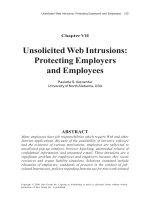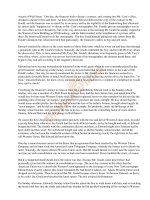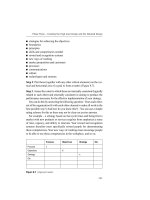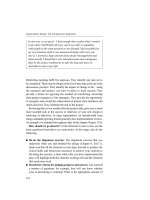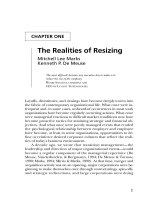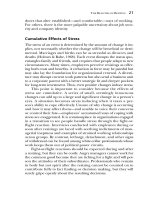Resizing The Organization 4 doc
Bạn đang xem bản rút gọn của tài liệu. Xem và tải ngay bản đầy đủ của tài liệu tại đây (92.39 KB, 10 trang )
ing will result in a leaner, meaner, smarter, and generally more
competitive organization. Unfortunately, now no one has the time
to think of smarter or better ways of doing things.
Support staff find themselves overwhelmed by the multiple de-
mands placed on them during a resizing. For example, human
resource (HR) professionals are staggered by the work load in pro-
cessing terminations and scheduling outplacement services. More-
over, knowing that their own area, a non-revenue-producing staff
function, is likely to be one of the hardest hit preoccupies them.
In the meantime, they are burdened by the line of employees out-
side their door waiting for an HR shoulder to cry on.
In general, resizing threatens the self-esteem and sense of fair-
ness of all employees. People can rationalize layoffs based on per-
formance, as when an employee is repeatedly late to work or fails
to meet production standards. However, people cannot rational-
ize the fact that hard-working fellow employees have lost their jobs
because of an economic downturn. Resizing victims blame them-
selves for not seeing it coming or not doing something to protect
themselves. For victims and survivors alike, a resizing eats away at
the assumption of fairness in the workplace as they wonder why
leadership could not stave off the dreaded event or identify some
alternative course of action. Survivors see the human carnage of
lost jobs and destroyed careers and wonder, “How could an orga-
nization I want to dedicate my life’s work to do this to people?”
Finally, some evidence suggests that resizing effects transcend
the employees themselves. The impact that job loss has on families
and communities initially was reported by Leana and Feldman
(1992). Several other researchers now are exploring the effect that
parents’ job insecurity has on such factors as children’s academic
performance and social development (Barling, Zacharatos, & Hep-
burn, 1999; Schmitt, Sacco, Ramey, Ramey, & Chan, 1999). Some
families report that elementary school children may revert to
thumb sucking and bed-wetting. Overall, research clearly shows that
organizational resizing activities affect families and communities.
Psychological Reactions
Some executives like to believe that resizing survivors should be
grateful just to have a job in tough economic times; they should
be ready to roll up their sleeves and get down to work. The real
THE REALITIES OF RESIZING 11
TEAMFLY
Team-Fly
®
12 RESIZING THE ORGANIZATION
consequences, however, are very different. Survivors of organiza-
tional transitions experience a broad range of psychological and
behavioral reactions that begin with rumors of impending events,
continue through the weeks and months of transition planning
and implementation, and linger long after the dust settles. They
have a lasting impact on employees’ perceptions of the work or-
ganization and expectations for its future (De Meuse, Bergmann,
& Lester, 2001). The work of rebuilding after a transition must
begin with accepting that there is unintended human and organi-
zational fallout from resizing, understanding these consequences,
and acting as proactively as possible to recover from them.
Survivor Syndrome
Symptoms of the layoff survivor syndrome have been well re-
searched and documented over the past decade (Brockner, 1989;
Brockner, Wiesenfeld, & Martin, 1995; Greenhalph, 1989). Often,
people feel guilty for having been spared, similar to the psycho-
logical reaction of children who lose a playmate or sibling in a fatal
accident. The survivor responds to the tragedy with extreme guilt
and asks, “Why couldn’t it have been me?” Survivors also may be-
come depressed at their inability to avert future layoffs or disrup-
tions to their work routine. In the short run, they become distracted
from their work responsibilities. Over the long haul, employees
who have been through a resizing have considerably less confi-
dence and trust in their employers (Buono & Bowditch, 1989; Marks,
2003; Noer, 1993).
Despite paring down the payroll, leaders of downsized compa-
nies find it difficult to realize the increases in productivity and cost
savings they had hoped the layoffs would produce. As U.S. News and
World Report noted, “The survivors of corporate downsizings are like
recovering casualties of a lost war—grateful to be alive, but uncer-
tain of what they are living for. Some have found opportunity amid
the carnage of fallen colleagues, but others have become deeply dis-
trustful and fearful that they may be next” (Boroughs, 1992, p. 50).
Loss of Confidence in Management
One of the most enduring symptoms of layoff survivor syndrome
is the erosion of employee confidence in management. Several fac-
tors contribute to this attitude. First, many employees wonder why
their leaders did not take action to prevent layoffs or avoid the ug-
liness of a plant closing. Second, employees do not see how tran-
sitions have added any value to the workplace. Outplacement
specialists Right Associates surveyed 909 firms that resized and
found that 72 percent of the employees still on the job did not
think the newly revamped company was a better place to work, and
70 percent felt insecure about their future in the firm. Third, there
is a growing sense that management is motivated by greed rather
than by concern for customers or employees.
The irony here is that layoffs, closings, and divestitures can be
productive tools to enhance organizational effectiveness and prof-
itability and, as a result, job security and quality of worklife. How-
ever, the way resizings are implemented and managed often
destroys workers’ regard and respect for their organizations and
leaders (Marks, 2003; Noer, 1997). In one national survey, nearly
three-quarters of employees whose companies were not involved
in a merger or layoff during the past year reported being confident
in the long-term future of their company. In contrast, only about
half of employees whose firms had been involved in a merger or
layoff were confident about their company’s future (Wiley, 1991).
Cynicism and Distrust
A major unintended consequence of resizing has been the growing
cynicism of the U.S. workforce. People do not mind enduring some
pain if they can see a payoff for it, but this has not been the case in
many organizational resizings. Promises that nothing will change
during the transition, and of enhanced effectiveness following it,
are rarely fulfilled. In many organizations, people see few benefits—
for the business or for themselves—resulting from the ordeal.
Poorly managed transitions have a negative not merely a neu-
tral effect on the mind-set of employees. Employees see how de-
parting senior executives have their transition impact softened with
the help of generous golden parachutes and how those who stay
often have well-endowed employment contracts (Strauss, 2001).
People have grown distrustful of their leadership and cynical of op-
portunities to succeed in their companies. A national study found
that 43 percent of working Americans doubt the truth of what
management tells them and believe that their companies, given a
chance, will take advantage of them (Kanter & Mirvis, 1989).
THE REALITIES OF RESIZING 13
14 RESIZING THE ORGANIZATION
Decreased Morale
The Laborforce 2000 study of downsizing and restructuring found
that morale dropped among surviving employees in six of every
ten companies engaged in a downsizing. Interestingly, the drop in
morale was the same whether companies downsized for strategic
reasons or to contain or control costs (Marks, 1993). Survivors are
angry, both at themselves for not seeing trouble before it arrived
and at their leaders for exposing people to such stressful treat-
ment. They hurt because the sight of coworkers being dismissed is
painful, as is accepting that one’s own career dreams have been de-
railed by downsizings and divestitures. And survivors are frustrated
because their ability to get the job done is hampered by the con-
fusion of the resized organization and because they see few signs
that things are going to get better any time soon.
Reduced Loyalty
During reductions in force, employers inadvertently hurt most the
employees they least wish to alienate: employees who are very loyal
to the organization. Most people who join organizations need to
feel that they are a part of and contributing to a larger collective.
One outgrowth of people’s need for group membership is that they
expect and want to be treated fairly by the groups to which they be-
long. Research conducted by a team from Columbia University sug-
gests that if loyal employees believe that layoffs were unfair, their
loyalty drops sharply, even more so than that of survivors who are
less committed at the onset (Brockner, 1989).
Dismal Outlook
Even for those who breathe a momentary sigh of relief for having
retained a job, dismal signs predominate in the resized organiza-
tion. Survivors feel sad about the past and anxious about the
future. People miss their former mentors, coworkers, and other
colleagues who may have exited in a divestiture or reduction in
force. They miss their former political connections to the power-
ful decision makers in the organization. When they set their sights
on the future, they become further dismayed. All signals point to
fewer opportunities for advancement when resizings eliminate tra-
ditional career paths. People even see themselves having to work
harder just to stay in the same place. Finally, there is less fun on
the job. The rhetoric of cost reduction puts a damper on the in-
formal perks and playfulness that many employees enjoy at work.
Loss of Control
What really concerns survivors is the sense that they have lost con-
trol over their work lives. They perceive that no matter how well they
do their jobs, they could be hit in the next wave of layoffs. The rapid
pace of change in today’s business world means that one’s position,
pet project, or potential for advancement could be eliminated at a
moment’s notice, with no way to counteract it. A middle-level man-
ager from a consumer products company exemplified the control
issue when he spoke with us during a interview a year after his com-
pany went through a series of resizings:
I used to think that if I did my job well, completed my projects on
time and in fine manner, I would be able to control my fate. That’s
no longer true. I’ve seen other managers—people who clearly were
good, if not excellent, performers—get the shaft. Now, my track
record doesn’t count for anything. I’m at the mercy of some bu-
reaucrat at headquarters. I’m no longer the master of my own fate.
While senior executives have the most at stake during a resiz-
ing in terms of position, power, pay, and perks, they also have the
most control over their situation. They anticipate, conceive, and
design the layoffs, closings, and divestitures, as well as arrange for
their financial security. Other employees cannot exert control over
whether their workplace is being resized, and their sense of lost
mastery over their fate extends well beyond the actual event.
Some people perceive that the only way they can regain con-
trol over their work situation is to walk away from the organization.
A research chemist whose firm had just closed and consolidated
R&D units was clear on her plans. She declared, “What is hard
work going to get me here? All I have been hearing from this or-
ganization is hard work is going to help me keep my job. Well,
that’s not good enough for me. I was raised in a time when good
work was rewarded with an occasional promotion. There was a ca-
reer path. Now with these layoffs and site closings, there is nowhere
to go. Why should I stay here?” Another manager, from a financial
services firm, had his plan set for taking back control. He boldly
revealed, “Senior management must think they have us by the balls
THE REALITIES OF RESIZING 15
16 RESIZING THE ORGANIZATION
right now, because the job market in our industry is poor. But I can
tell you this. At the sight of the first ray of light of an upturn in the
economy, I’m walking out of here and not looking back.” When
surviving employees see the best and brightest performers jump-
ing ship, it reinforces negative feelings and cynical attitudes. And,
importantly, it is these highly skilled and creative individuals whom
an organization must hold onto to rebound effectively after the
resizing.
Behavioral Reactions to Resizing
Employees who survive a resizing often liken their situation to that
of a chicken with its head cut off—frantically moving about with-
out any sense of direction or hope for survival. Or they talk about
struggling to keep their heads above water. They know what they
have to do, but they are weighed down by the burden of a heavy
workload with competing demands. Others keep their heads in the
sand like ostriches, hoping that the winds of change will blow
by them.
Working Harder, Not Smarter
The workload rarely gets smaller when the workforce does. Sur-
vivors who return to work following reductions in force face the
dismal prospect of being part of the 80 percent of the people who
now have to do 100 percent of the work. Everyone is working
harder but feeling as though they are accomplishing less. The sit-
uation is exacerbated by a likely backlog in the workload carried
over from the months preceding the resizing, as people were pre-
occupied with rumors and gossip and distracted from doing their
jobs. Inevitably, work falls through the cracks.
What about the promise of enhanced organizational effective-
ness that accompanies the announcement of many organizational
resizings? The reality is that no one has time to stop and think of
innovative ways to approach work. Work teams or task forces may
be convened to identify ways to eliminate non-value-added work.
Typically, however, these groups are insufficiently prepared to over-
come the group dynamics and individual power plays that can side-
track team creativity and decision making. When these groups fail
to produce enhancements to the workplace, people become more
dismayed toward their situation and cynical about the future.
Worse yet, when outside consultants are brought in to recommend
new ways of approaching work, employees fear the worst and as-
sume this means more job cuts lie ahead.
Meanwhile, there are demands from all directions—superiors,
peers, and subordinates—that increase the pressure on transition
survivors. “Everybody here is so worried about looking good and
wants their work to take top priority,” noted a staff analyst in a high-
tech company. “My boss says to ask my internal customers if what
they need in a week can instead be delivered in ten days. But I’m
afraid to do that. It may cost me by being labeled as someone who
can’t cut it around here.”
Lack of Direction
Compounding the sheer volume of work confronting people sur-
viving resizing is a lack of direction in prioritizing which tasks to
tackle first. After two regional offices of a health maintenance or-
ganization were combined as part of a cost-cutting series of clos-
ings, leadership was indecisive regarding the relative merits of
aggressively pursuing increases in membership or conservatively
maintaining levels of profitability. Middle managers were paralyzed
by this lack of direction, waiting to see which way they should lead
their work teams. The director of operations expressed this frus-
tration: “Does senior management want us to go out and run up
the membership roles, or are they interested in protecting the mar-
gin? Either one is fine by me, but someone has got to let me know
which way we are going, because I do not want to build an organi-
zation that is headed one way and then get chastised because I was
supposed to go the other way.”
Risk Avoidance
Why wouldn’t the operations manager and his peers just step up
to the plate and make a decision on their own? The answer is that
risk taking plummets following a resizing. Employees are so scared
that there is a self-imposed pressure not to make waves or take
risks, and just at the time when innovation is needed. Further cuts
may be in the offing, and no one wants a blemish on their record
that may be used against them when the next list of victims is
drawn up. Instead, managers and employees go with what they
THE REALITIES OF RESIZING 17
18 RESIZING THE ORGANIZATION
know, relying on what has worked for them in the past. These are
just the behaviors that have gotten the organization in trouble. At
the very least, what may have worked in the past is unlikely to work
within a new context of changed market, workplace, and social
demands.
Political Behavior and Loss of Team Play
Political game playing increases sharply in organizations that have
resized. One way people shore up their sense of control is to lobby
for themselves. Employees spend time promoting their value to ex-
ecutives and managers, as well as reminding them of any outstand-
ing favors that may be owed. They network with friends and
associates from outside the organization—a distraction from get-
ting their work done but an important protective action to take in
the event of future layoffs. Coworker relations may become strained
as individuals explicitly or implicitly put down their colleagues in
an effort to make themselves look better in the eyes of superiors. As
uncertainty grows, self-preservation becomes paramount.
Politics prevails also at the group level as work teams look out
for themselves. Managers erect barriers between teams, focusing
on group results rather than the big picture. In the short run, they
conclude that what makes the team look good is more important
than what is best for the overall organization over the long haul.
Role Ambiguity
A constant problem interfering with organizational effectiveness
following resizing is role ambiguity. Survivors wonder who is re-
sponsible for what and whom to go to for which decisions. A lot of
time is spent wondering how to prioritize work and how to oper-
ate in an environment in which direction is not forthcoming. In-
dividuals reporting to new superiors fret over when to make
decisions on their own and when to raise them up to leaders, as
well as wondering what detail to provide when communicating.
These normal aspects of the learning curve of any new work rela-
tionship become sensitive issues within the context of resizing. It
is especially frustrating to achievement-oriented people who want
to start building a good track record in the resized organization.
They hope to make a positive first impression on new superiors,
peers, and subordinates, yet they do not always know whom to go
to or work with to get the job done right and on time.
Withdrawal
According to Herman Maynard, a former senior manager at Dupont
who took early retirement in a reduction in force, these psycho-
logical and behavior reactions to resizing have prompted many em-
ployees “to withdraw their personal and professional power from
their jobs, while making it look like they are still working”
(Reynolds, 1992). People’s bodies, but not their hearts and souls,
show up to work. As executives exhort their employees to boost
productivity, improve quality, and be more globally competitive,
many workers are responding with a shrug. This psychological
turnover is more costly for the organization than actual turnover.
Often, these employees are riding out the organizational storm
until the next early retirement enticement or enhanced severance
pay package is offered. In the meantime, they continue to receive pay
and benefits and perform poorly.
Stress and Organizational Resizing
A moderate amount of stress enhances performance, but high lev-
els of stress have a detrimental effect on work productivity and
quality. During and after a resizing, people become distracted from
doing their jobs. They huddle around coffee makers and water
coolers, exchanging the latest rumors. Some employees are at the
copying and fax machines, preparing and sending out their re-
sumés. High levels of stress interfere with cognitive processes in in-
tellectual tasks and with the quality of work produced on manual
tasks. People respond in robot-like ways instead of thinking cre-
atively or strategically about the situation at hand. One vice presi-
dent of quality control at an aerospace firm involved in repeated
waves of resizing described it as “like waiting for an earthquake—
you do not know when the next shocks will be felt, but you know
they will be coming. And you do not know if this will be the big one
or not.”
Sources of Stress in a Resizing
Resizing creates stress for employees in a variety of ways. The loss
of someone or something to which people are attached is painful,
and it necessitates a period of mourning or depression while they
make adjustments in their lives (Kübler-Ross, 1969). The potential
THE REALITIES OF RESIZING 19
20 RESIZING THE ORGANIZATION
for loss abounds in a resizing: people may lose their jobs, cowork-
ers, title, status, or perks. They also may lose less tangible aspects
of their work situation, like the opportunity to realize their career
aspirations, achievement of their ego ideal, their sense of personal
competence, and their identification with what had been regarded
as a paternalistic and caring employer.
A key to understanding the stress of resizing is to realize that
the threat of loss is as debilitating as actual loss. Whether the threat
is to a person’s self-esteem or physical person, the resulting stress
response is the same. Job insecurity is experienced like job loss.
Laying awake at night worrying about losing one’s job is as debili-
tating as losing it. In fact, survivors in companies experiencing mul-
tiple waves of resizing report being envious of the victims who lost
their jobs; at least they can get on with their lives. Resizing survivors
also worry about not fitting into a new company direction or cul-
ture, lament about having to prove their worth to new superiors,
and agonize over what might happen to their career, all of which
produce stress. Importantly, stress is based on subjective percep-
tions, not objective reality. It matters not what senior leadership in-
tends to do or thinks are opportunities for the future, but what
people fear leaders may do and how they perceive opportunities in
the resized organization.
Next, the frustration experienced when anyone or anything
even potentially prevents a person from meeting basic needs or
getting what they want is another source of stress. People incur
added stress when they feel helpless to do anything about their sit-
uation. This is why long hours of work during and following an or-
ganizational transition do not necessarily create higher levels of
stress. In contrast, a high degree of pressure coupled with a per-
ceived lack of control will cause high anxiety. When people feel
their control has been reduced, they wrongly assume that they have
lost all control. Frustration is at its worst when a person has little
perceived discretion to negotiate deadlines and manage workloads.
Finally, the critical mass of uncertainty in a resizing is a source
of stress. The announcement of a reduction in force, closing, or
divestiture usually creates more questions than answers. People do
not know what to expect, and in today’s environment, they gener-
ally anticipate the worst. Some may have new duties to master, a
new superior and peers to adjust to, and new policies and proce-

